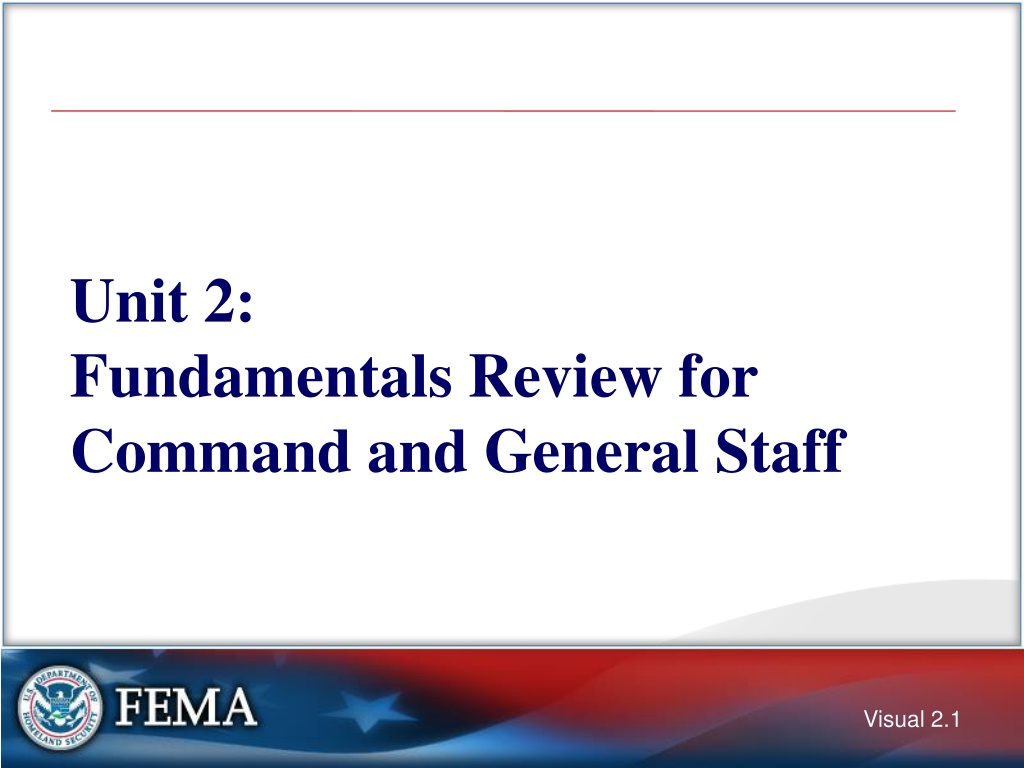Incident Management Fundamentals and Command Structure Review
Explore key NIMS doctrine concepts, agency policies, incident complexity factors, and Unified Command functions in managing complex incidents or events. Learn about Incident Action Planning, transfer of command, and the roles of Command and General Staff positions. Gain insights into incident complexity, differentiating terms, and conducting review activities for enhanced understanding.
Download Presentation

Please find below an Image/Link to download the presentation.
The content on the website is provided AS IS for your information and personal use only. It may not be sold, licensed, or shared on other websites without obtaining consent from the author. Download presentation by click this link. If you encounter any issues during the download, it is possible that the publisher has removed the file from their server.
E N D
Presentation Transcript
Unit 2: Fundamentals Review for Command and General Staff Visual 2.1
Unit Terminal Objective Given a scenario and review materials, apply key NIMS doctrine concepts (NIMS Management Characteristics, Unified Command, Incident Command System structure and functional area responsibilities, IAP Preparation and the Operational Period Planning Cycle, and incident complexity) to the management of a complex incident or event. Visual 2.2
Unit Enabling Objectives Describe types of agency(ies) policies, guidelines, and agreements that influence management of incident or event activities. Describe issues that influence incident complexity, complex incidents, and Incident Complex and the tools available to analyze complexity. Describe the process for transfer of command. Describe the primary guidelines and responsibilities of the Command and General Staff positions. Visual 2.3
Unit Enabling Objectives (Cont.) List the major steps in the Incident Action Planning Process. Describe the purposes and responsibilities of Agency Representatives or technical specialists, reporting relationships, and how they can be used effectively within the incident organization. Define the advantages of Unified Command and list the kinds of situations that may call for a Unified Command organization. Describe how Unified Command functions on a multi-jurisdiction or multi-agency incident. Visual 2.4
Incident Complexity and Types Visual 2.5
Incident Complexity, Complex Incidents, and Incident Complex Commonly misused terms. Language matters use the correct term and ensure that your audience understands what you intend. Define each. Differentiate between. Visual 2.6
Activity 2.1: Review Activity Allotted Time: 2 hours 45 minutes Visual 2.7
Activity 2.1: Debrief Group and Points to Cover Group 1 Group 2 Group 3 Primary responsibilities of the Unified Command Primary responsibilities of the Officers Group Group 1 Points to Cover Primary responsibilities of the Unified Command Primary responsibilities of the Officers Operations Section Chief responsibilities Tactical resource needs Span of control Ops Section organizational structure Primary responsibilities and challenges of the Planning Section Chief Technical specialists Primary responsibilities and challenges of the Logistics Section Chief Primary responsibilities and challenges of the Finance/Admin Section Chief Operations Section Chief responsibilities Tactical resource needs Span of control Ops Section organizational structure Primary responsibilities and challenges of the Planning Section Chief Technical specialists Primary responsibilities and challenges of the Logistics Section Chief Primary responsibilities and challenges of the Finance/Admin Section Chief Group 2 Group 3 Visual 2.8
Activity 2.1: Debrief (Cont.) Group Group 4 Points to Cover Planning process responsibilities Types of policies, guidelines, or agreements Length of first operational period Initial incident objectives Major steps/meeting conducted ICS forms used Unified Command advantages Jurisdictions/agencies included in the Unified Command structure Top three challenges associate with using Unified Command Strategies to address challenges Group and Points to Cover Group 4 Group 5 Planning process responsibilities Types of policies, guidelines, or agreements Length of first operational period Initial incident objectives Major steps/meeting conducted ICS forms used Unified Command advantages Jurisdictions/agencies included in the Unified Command structure Top three challenges associate with using Unified Command Strategies to address challenges Group 5 Visual 2.9
Objectives Review Describe types of agency(ies) policies, guidelines, and agreements that influence management of incident or event activities. Describe issues that influence incident complexity, complex incidents, and Incident Complex and the tools available to analyze complexity. Describe the process for transfer of command. Describe the primary guidelines and responsibilities of the Command and General Staff positions. Visual 2.10
Objectives Review (Cont.) List the major steps in the Incident Action Planning Process. Describe the purposes and responsibilities of Agency Representatives or technical specialists, reporting relationships, and how they can be used effectively within the incident organization. Define the advantages of Unified Command and list the kinds of situations that may call for a Unified Command organization. Describe how Unified Command functions on a multi-jurisdiction or multi-agency incident. Visual 2.11























